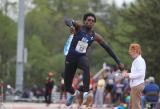Folders |
It's the Year of the Mile in boys track - DyeStatPublished by
'Holy Grail' moments spur mile comeback
By Doug Binder, DyeStat Editor
The mile – that so very non-metric of track events – has become the hot topic of discussion and the must-see event at big meets this spring.
With Matthew Maton’s sub-four last week now in the books, and loads of anticipation that Grant Fisher has one inside him as well, 2015 has turned into the Year of the Boys Mile.
This weekend marks the 50th anniversary of the only sub-four minute mile ever run at a state championship. Jim Ryun ran 3:58.3 on May 15, 1965 all by himself at the Kansas state meet on the cinders at Wichita State University.
In the five decades that ensued the mile in the U.S. went through its ups and downs. At the high school level most state associations abandoned the mile in favor of the metric distances 1,600 meters or 1,500 meters by the early 1980s. Only Massachusetts today runs a full mile at its state championships.
But there is an unmistakable resurgence happening. The drum beat coming from Bring Back The Mile, an organization launched in early 2012 to promote and preserve the mile, has moved the needle on awareness.
The adidas Grand Prix Dream Mile in New York City, started in 2010 at the IAAF Diamond League meet, has captured the imaginations of the top high school runners in the country. This season, it seems, all of the top runners want to run a fast mile time and qualify for the Dream Mile.
“For me, I don’t have a good mile time and I want to work on the mile,” North Central Spokane WA’s Tanner Anderson said. “If you’re a senior and you have your scholarship to your school, (3200 PRs) don’t matter. If you can get your mile time down before you get to college it’s a confidence booster. Plus, I think there’s all the hype about what Grant (Fisher) and Matthew (Maton) have done. Grant stepping on the rail (at New Balance Nationals Indoor), all those type things factor in. But all these guys are gunning for the mile and I’m going for it, too.”
It’s music to the ears of Ryan Lamppa, who founded Bring Back the Mile.
“Athletes and coaches are talking more and more about breaking four (minutes),” Lamppa said. “We have an engaged following and we truly believe that the mile resonates in America. We understand it. The sub-four mile is our Holy Grail of sorts.”
Even as Bring Back the Mile has sought to – among other things – convince state associations to trade in the 1,600 for the mile, the event has found more and more traction at some of the nation’s biggest invitational meets.
Since the Dream Mile surfaced in 2010, meet directors who are in many cases more plugged into the big picture of the sport than state association officials have made the switch.
In 2010, the Chandler Rotary Invitational in Arizona moved from the 1,600 to the mile (although it still times both distances).
In 2011, the Azusa Meet of Champions in California and the Pasco Invitational in Washington switched to the mile. In 2013, the Loucks Games in New York switched to the mile. And in 2015, the Jesuit Twilight Relays in Oregon and the Golden Triangle Invitational in Michigan have gone to the mile.
And that’s not a complete list. Some other meets have maintained miles for years. But the tide is rising.
On Friday in Connecticut, the Danbury Dream Invitational is built around a boys mile -- Alex Ostberg aims to seek a time faster than 4:05. Already this year, Andrew Hunter (Virginia) and Carlos Villarreal (Arizona) have run under 4:04 for 1,600 meters and Austin Tamagno (California) has run 3:46 for 1,500.
The overall result is more mile times, Lamppa said, and more high school runners who can relate to the achievement of Roger Bannister’s historic effort in 1954.
“The standard of sub-four is so embedded in our sport and in our culture,” Lamppa said. “It’s the standard that’s the most relatable to (non-track fans).”
Making a difference, whether it’s promoting mile races or unearthing the history of a storied past, has been the Bring Back the Mile group’s mission.
One tangible success was in lobbying the IAAF to accept mile times for world championships qualifying for the 1,500 meters.
Moving the hearts and minds of the governing bodies within state associations may prove to be an even bigger task.
“All we need is one enlightened official,” Lamppa said.
Even if it’s a long wait, Bring Back the Mile is willing to press on at a steady pace.
And in the meantime, Lamppa will gladly point out the virtues of the 1,760-yard (1,609-meter) race.
“Seeing Matthew (Maton) on the track last Friday, prone, with his hands together like he was praying while he waited for the time, was awesome,” Lamppa said. “Breaking four in the 1,600 doesn’t have the same meaning.”
What Lamppa would love to see is something else historic: Two high school runners going sub-four in the same year.
“If the Dream Mile in New York has some magic in it, that event could be the tipping point,” he said. More news |






